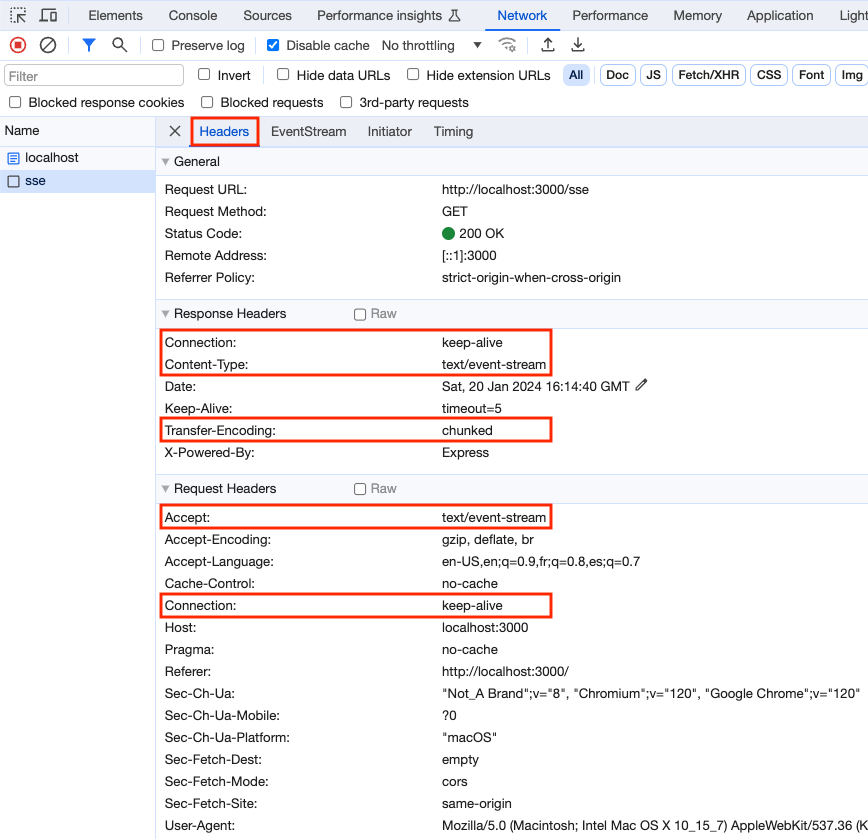Overview
Polling is a technique that web clients can use to get changing data from a server. The easiest way to implementing polling is to send requests to a server at fixed time intervals, such as once every 30 seconds.
Polling is useful in many scenarios such as getting updates to sports scores, stock prices, and weather forecasts.
Fixed interval polling has drawbacks. The data presented can be out-of-date until the next request/response completes. Also, there is more network traffic and server load than necessary because many consecutive requests can result in the same response.
Long polling addresses the issues with fixed interval polling. The client sends an initial request for data. The server does not respond until there is a change in the data to be reported. When the client receives the data, it immediately requests the next update.
All the example code below can be found in the GitHub repository long-polling-examples.
Demo Client
The following code is an example client HTML file that connects to the server and receives long polling responses. This uses a bit of Alpine to simplify the DOM manipulation.
<!DOCTYPE html>
<html lang="en">
<head>
<title>Long Polling Demo</title>
<script defer src="//unpkg.com/alpinejs"></script>
<script defer>
async function longPoll() {
const res = await fetch('/score');
const score = await res.text();
const scoreP = document.getElementById('score');
scoreP.innerText = score;
// When a score is received, immediately ask for the next update.
longPoll();
}
longPoll();
</script>
</head>
<body x-data="{name: '', score: ''}">
<h1>Long Polling Demo</h1>
<p id="score"></p>
<!-- This demonstrates that user interaction is not blocked
while waiting for the next score update. -->
<label>
Name:
<input type="text" x-model="name" />
</label>
<p x-show="name">Hello, <span x-text="name"></span>!</p>
</body>
</html>If the server is restarted, the client will not automatically reconnect.
Demo Server
Responses sent from a long polling endpoint must set the "Transfer-Encoding" header to "chunked".
The following server code uses Node.js and the Express library.
import express from 'express';
const app = express();
app.use(express.static('public'));
let chiefsHaveBall = true;
let bills = 0;
let chiefs = 0;
let lastScore;
// Randomly get points for a touchdown, field goal, or nothing.
function getPoints() {
const number = Math.floor(Math.random() * 10);
const touchdown = 7;
const fieldGoal = 3;
return number >= 8 ? touchdown : number >= 6 ? fieldGoal : 0;
}
function getScore() {
if (chiefsHaveBall) {
chiefs += getPoints();
} else {
bills += getPoints();
}
chiefsHaveBall = !chiefsHaveBall;
return `Chiefs: ${chiefs}, Bills: ${bills}`;
}
const sleep = ms => new Promise(resolve => setTimeout(resolve, ms));
app.get('/score', async (req, res) => {
let score;
while (true) {
score = getScore();
if (score !== lastScore) break;
await sleep(2000);
}
lastScore = score;
res.setHeader('Transfer-Encoding', 'chunked');
res.write(score);
res.end();
});
app.listen(3000, function () {
console.log('listening on port', this.address().port);
});The following package.json file can be used to start the Node server.
{
"name": "long-polling",
"type": "module",
"scripts": {
"dev": "nodemon src/server.js"
},
"dependencies": {
"express": "^4.18.2"
},
"devDependencies": {
"nodemon": "^3.0.3"
}
}Running Demo
To run this demo, enter npm install, enter npm run dev, and browse localhost:3000. The scores will continually update, but not at a fixed rate. Requests for score updates do not block user interactions. A name can be entered in the text input and a greeting will appear below it.
The following screenshot shows the request and response HTTP headers for the SSE connection.

The following screenshot shows the event stream for the SSE connection.

Bun and Hono
The server code is a bit simpler when using Bun and Hono instead of Node and Express. The client code remains the same.
import {Hono} from 'hono';
import type {Context} from 'hono';
import {serveStatic} from 'hono/bun';
const app = new Hono();
app.use('/*', serveStatic({root: './public'}));
let chiefsHaveBall = true;
let bills = 0;
let chiefs = 0;
let lastScore;
// Randomly get points for a touchdown, field goal, or nothing.
function getPoints() {
const number = Math.floor(Math.random() * 10);
const touchdown = 7;
const fieldGoal = 3;
return number >= 8 ? touchdown : number >= 6 ? fieldGoal : 0;
}
function getScore() {
if (chiefsHaveBall) {
chiefs += getPoints();
} else {
bills += getPoints();
}
chiefsHaveBall = !chiefsHaveBall;
return `Chiefs: ${chiefs}, Bills: ${bills}`;
}
app.get('/score', async (c: Context) => {
let score;
while (true) {
score = getScore();
if (score !== lastScore) break;
await Bun.sleep(2000);
}
lastScore = score;
c.header('Transfer-Encoding', 'chunked');
return c.text(score);
});
export default app;The following package.json file can be used to start the Bun server.
{
"name": "bun-long-polling",
"type": "module",
"scripts": {
"dev": "bun run --watch src/server.ts"
},
"dependencies": {
"hono": "^3.12.6"
},
"devDependencies": {
"@types/bun": "latest"
},
"peerDependencies": {
"typescript": "^5.0.0"
}
}To run this demo, enter bun install, enter bun dev, and browse localhost:3000.
Alternatives
Another alternative is Server-Sent Events.
If data must be sent in both directions, consider using WebSockets.